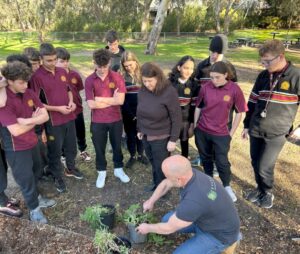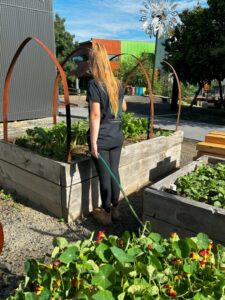
Why Australia must invest in urban nature
By Michael Casey
Greener cities mean healthier lives for their inhabitants. If we are to prevent disease, improve mental health, and create resilient, liveable communities in Australia, we must invest in urban nature.
Australia faces a growing public health challenge: the rising burden of preventable chronic disease. A recent report from the Centre for Policy Development (CPD) on avoidable healthcare costs highlights the scale of the opportunity, estimating that billions of dollars in healthcare expenditure could be prevented through effective upstream interventions1. Healthy Cities Australia in their report summarised these findings, emphasising that ‘for every $1 spent on prevention, there is a $4 return in avoided healthcare costs,’2 framing preventive strategies as both an economic and social imperative. While public health conversations often focus on diet, exercise and vaccination, there is an increasingly recognised avenue for prevention that is too often overlooked: the urban environment. Integrating green infrastructure into cities offers tangible health benefits, improving both physical and mental wellbeing while reducing long-term healthcare burdens.
Access to nature has for some time been seen as a luxury but in recent times it is now being recognised as a public health priority. Evidence from Australia demonstrates this clearly with a recent study of more than 46,000 adults finding that ‘adults living in areas with more green space had lower odds of psychological distress and self-reported depression’ and that ‘greater neighbourhood green space was associated with better general health, independent of socio-demographic factors’3. These findings show that urban greenery is not just visually appealing but a measurable factor in reducing stress, enhancing mental health, and supporting overall wellbeing. Green infrastructure, therefore, is not simply about aesthetic improvements but, most importantly, it is about critical preventive health strategy.

Green infrastructure goes far beyond conventional parks. It includes green roofs, living walls, urban forests, rain gardens and permeable landscapes, all of which can be integrated into areas where traditional green space is limited. Each intervention provides co-benefits such as green roofs filtering pollutants and mitigating urban heat islands, street trees providing shade and improving air quality, and rain gardens managing stormwater while creating accessible community spaces. As Healthy Cities Australia notes, ‘the built environment is responsible for shaping how people move, interact, and ultimately how healthy they are,’ 2 linking urban design directly to long-term health outcomes.
Streetscapes play a vital role in connecting people with nature. Thoughtfully designed street trees and urban canopy can significantly improve health outcomes by reducing heat exposure, encouraging physical activity, and providing accessible spaces for community interaction. The City of Melbourne notes that ‘urban forest canopy helps to reduce local temperatures, improving comfort for people outdoors and encouraging walking and cycling’4. This demonstrates how integrating vegetation into streetscapes, laneways and public spaces is more than beautification as it directly influences mental and physical wellbeing, supporting healthier, more active lifestyles.
Mental health remains a pressing concern. According to the Australian Bureau of Statistics, one in six Australians experienced an anxiety-related condition in the previous 12 months, among the highest rates reported in comparable high-income countries5. Urban isolation further exacerbates these challenges, highlighting the urgent need for accessible green infrastructure as a preventive measure. Access to urban nature has been linked to improved cognitive function, reduced rumination and lower stress levels. Community gardens, greened laneways and biodiversity roofs in cities like Melbourne and Sydney exemplify this as they offer spaces for informal exercise, social interaction, and connection with the natural world. In short, planting streets, roofs and public spaces is not just a design choice, it is prevention in action.
Equity in access is also critical. Socioeconomically disadvantaged communities often have the least access to high-quality green spaces, amplifying health disparities. Thoughtful planning, including street trees, rain gardens and subsidised green roofs in multi-unit residential developments can bridge this gap ensuring all Australians benefit. The Australian Institute of Health and Welfare notes that equitable access to urban nature is associated with reduced healthcare burdens, particularly for chronic diseases and mental health challenges6. Green infrastructure, therefore, is also a matter of social justice.

From a practical standpoint, the case for green infrastructure is compelling. Beyond health, these solutions enhance biodiversity, manage stormwater, reduce noise, mitigate urban heat and improve property values. Tree canopy programs in Sydney have been shown to reduce local summer temperatures by up to 2°C, directly lowering heat-related illness risk. Rain gardens and permeable pavements manage runoff while creating visually appealing, accessible spaces that encourage physical activity. Essentially, every dollar invested in green infrastructure yields multiple societal benefits in the health, environmental, social and economic sectors.
Australia stands at a pivotal moment. As Healthy Cities Australia emphasises, ‘the cost of inaction is far greater than the cost of proactive prevention.’ 2 Green infrastructure is no longer an optional aesthetic choice but a vital preventive health strategy with clear evidence highlighting that adults living in greener areas experience lower stress and better general health3. By prioritising and investing in green infrastructure, Australia can simultaneously reduce chronic disease, enhance mental wellbeing and strengthen the liveability and prosperity of its communities.
References
- Centre for Policy Development. (2025, June 25). Avoidable Costs: Better outcomes and better value for public money. https://cpd.org.au/work/avoidable-costs/
- Healthy Cities Australia. (2025, August 7). The $4 billion opportunity we can’t ignore: Why prevention must be Australia’s top health priority. https://healthycities.org.au/2025/08/07/the-4-billion-opportunity-we-cant-ignore-why-prevention-must-be-australias-top-health-priority/
- Astell-Burt, T., & Feng, X. (2019). Association of urban green space with mental health and general health among adults in Australia. JAMA Network Open, 2(7), https://jamanetwork.com/journals/jamanetworkopen/fullarticle/2739050
- City of Melbourne. (2023). Urban Forest Strategy 2023–2033. pp. 21–22
- Australian Bureau of Statistics. (2023, December 13). National Health Survey: First Results, 2021–22. https://www.abs.gov.au/statistics/health/health-conditions-and-risks/national-health-survey-first-results/latest-release
- Australian Institute of Health and Welfare. (2023). Urban green spaces and health outcomes.
Michael Casey
Director, Evergreen Infrastructure
Company Director, Australasian Green Infrastructure Network
Technical Panel, AIPH World Green Cities Awards
World Ambassador for World Green Roofs Day
E: michael@evergreeninfrastructure.com.au
